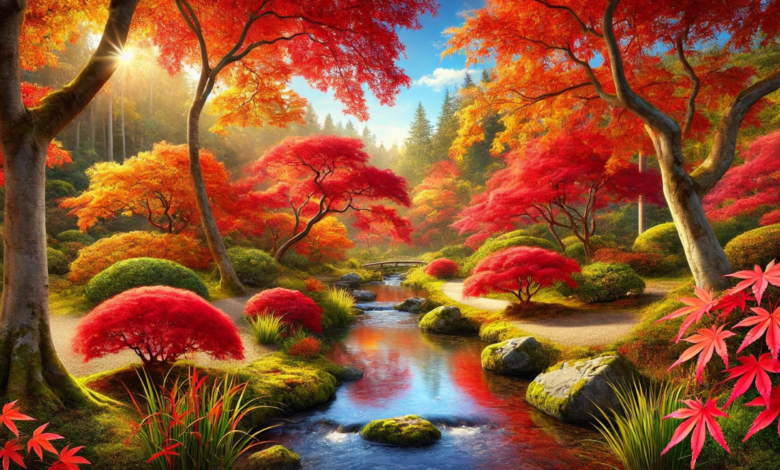The Enchanting World of Maple Trees: Nature’s Gift of Beauty and Utility

Maple trees, scientifically known as Acer, are among the most cherished and recognizable trees in the temperate parts of the world. Known for their striking beauty and practical utility, these trees grace landscapes with their vibrant foliage and contribute significantly to local ecosystems and economies. This article delves into the world of maple trees, exploring their types, ecological importance, and uses, as well as the simple joy they bring to those who encounter them.
Introduction to Maple Trees
Maple trees belong to the plant family Sapindaceae and the genus Acer. With approximately 130 species, the genus exhibits remarkable diversity, particularly in Asia, North America, and Europe. These trees are particularly noted for their distinctive leaf patterns—most commonly a palmate shape with 3 to 5 lobes—and their dramatic autumn colour change, transitioning from lush green to fiery reds, oranges, and yellows.
Types and Characteristics of Maple Trees
Maple species vary widely in size, form, and habitat preferences, each adapted to specific environmental conditions. Some of the most well-known species include:
- Sugar Maple (Acer saccharum): Famous for its sweet sap, the primary source of maple syrup, this species also boasts spectacular fall colours.
- Red Maple (Acer rubrum): Known for its adaptability to various climates and soils, the red maple displays vibrant red foliage in the fall.
- Japanese Maple (Acer palmatum): Prized in ornamental gardens for its varied leaf shapes and colours, this species is smaller and suited for decorative purposes.
The physical attributes of these trees contribute not only to their beauty but also to their utility. Maple wood is well-known for its toughness and longevity, making it a favoured material in the furniture industry and for hardwood flooring.
Ecological Benefits
Maples play significant roles in their ecosystems Certified Arborist in Dallas. They serve as essential sources of food and shelter for wildlife. Birds and small mammals often feed on the samaras (the winged seeds), while the dense foliage offers shelter and nesting sites. Moreover, maples contribute to the ecosystem’s health by improving air quality and offering shade, which helps reduce ground temperatures and conserve soil moisture.
Cultural and Economic Importance
Beyond their ecological value, maple trees hold substantial cultural significance in many cultures. The national symbol of Canada is the maple leaf featured on the flag, while in Japan, viewing the changing colours of maples (Momiji-gari) is a popular autumn activity. Economically, maples are vital for the production of syrup and sugar. The maple syrup industry is a significant economic contributor in regions like Vermont and Quebec, where conditions are ideal for sap collection.
Growing and Caring for Maple Trees
Growing maple trees can be a rewarding endeavour for any gardener. They generally require well-drained soil and adequate sunlight, but specific needs vary among species. For instance, Japanese maples might prefer shade to protect their delicate leaves from scorching. Regular pruning helps maintain their shape and health, and mulching can aid in moisture retention and temperature regulation for the roots.
Challenges and Conservation
Despite their resilience, maple trees face several challenges, including pests, diseases, and climate change. The Asian long-horned beetle and tar spot disease are notable threats that can damage these trees significantly. Conservation efforts are crucial to protect these majestic trees, monitoring tree health, controlling pest outbreaks, and supporting healthy forestry practices.
Conclusion
Maple trees are more than just a syrup source or a shade provider; they are integral to cultural identities and ecological systems. Their stunning fall foliage reminds us annually of nature’s cycles and beauty. Whether planted in a garden or growing wild in a forest, maple trees continue to enchant and serve the environments and communities around them.
FAQs: Maple Treê
What are the most common types of maple trees?
The most common types include the Sugar Maple (Acer saccharum), known for producing maple syrup; the Red Maple (Acer rubrum), recognized for its vibrant red foliage in fall; the Japanese Maple (Acer palmatum), famous in ornamental gardening due to its diverse leaf shapes and colours; and the Silver Maple (Acer saccharinum), which proliferates and is often found in urban environments.
How do you care for a maple tree?
Depending on the species, maple trees require well-drained soil and full to partial sun exposure. Regular watering during dry periods, annual mulching to retain soil moisture, and pruning to maintain shape and health are essential care steps. Each species may have specific needs, especially regarding sunlight and soil type.
Can all maple trees produce maple syrup?
No, not all maple trees can produce sap suitable for maple syrup. The best sap for maple syrup comes from the Sugar Maple (Acer saccharum) because of its high sugar content. Other species, like the Black Maple (Acer nigrum) and the Red Maple (Acer rubrum), can also be tapped for syrup, but the sugar content is lower, so they are less commonly used.
Why do maple leaves change colour in the autumn?
Maple leaves change colour ducolourchanges in daylight and temperature, leading to the breakdown of chlorophyll (which gives leaves their green colour). colourlorophyll diminishes, and other pigments in the leaves, such as carotenoids and anthocyanins, become visible, displaying the vibrant reds, oranges, and yellows typical in fall.
What are some challenges maple trees face?
Maple trees are susceptible to various pests and diseases, such as the Asian long-horned beetle, which can damage wood and even kill trees. They also face tar spot disease and other fungal infections affecting leaf health. Climate change poses additional stress, impacting growth conditions and sap production for species like the Sugar Maple.
You May Also Read: Something Shared by Wetlands and Woodwinds: A Symphony of Nature and Music




